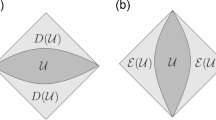Abstract
In this paper we consider the degrees of freedom beyond the graviton present in the effective field theory for quantum gravity. We point out that the position of the poles due to \({{R}^{2}}\) and \({{R}_{{\mu \nu }}}{{R}^{{\mu \nu }}}\) cannot be affected by operators that are higher order in curvature. On the other hand, operators of the type \(R\square R\) will lead to new poles while shifting the positions of the poles found at second order in curvature. New degrees of freedom can be identified either, as just described, by looking at the poles of the graviton propagator corrected by quantum gravity or by mapping the Jordan frame theory to the Einstein frame theory. While this procedure is very well defined for second order curvature terms in the effective action, we point out that higher order terms in curvature lead to a nonlinear and non-local relation between the propagating scalar degree of freedom and the Ricci scalar. We show how to resolve these ambiguities and how to obtain the correct action in the Einstein frame. We illustrate our results by looking at \(f(R)\) gravity.
Similar content being viewed by others
REFERENCES
S. Weinberg, in General Relativity. An Einstein Centenary Survey, Ed. by S. W. Hawking and W. Israel (Cambridge Univ. Press, Cambridge, 1979), p. 790.
J. F. Donoghue, Phys. Rev. D 50, 3874 (1994); gr-qc/9405057. https://doi.org/10.1103/PhysRevD.50.3874
A. O. Barvinsky and G. A. Vilkovisky, “The generalized Schwinger-de Witt technique and the unique effective action in quantum gravity,” Phys. Lett. B 131, 313 (1983).
A. O. Barvinsky and G. A. Vilkovisky, Phys. Rep. 119, 1 (1985). https://doi.org/10.1016/0370-1573(85)90148-6
A. O. Barvinsky and G. A. Vilkovisky, “Beyond the Schwinger-Dewitt technique: converting loops into trees and In-In currents,” Nucl. Phys. B 282, 163 (1987).
A. O. Barvinsky and G. A. Vilkovisky, “Covariant perturbation theory. 2: Second order in the curvature. General algorithms,” Nucl. Phys. B 333, 471 (1990).
I. L. Buchbinder, S. D. Odintsov and I. L. Shapiro, Effective Action in Quantum Gravity (IOP, Bristol, UK, 1992).
X. Calmet, Phys. Lett. B 787, 36 (2018); arXiv: 1810.09719 [hep-th]. https://doi.org/10.1016/j.physletb.2018.10.040
K. S. Stelle, Gen. Rel. Grav. 9, 353 (1978). https://doi.org/10.1007/BF00760427
L. Alvarez-Gaume, A. Kehagias, C. Kounnas, D. Lüst, and A. Riotto, Fortsch. Phys. 64, 176 (2016); arXiv: 1505.07657 [hep-th]. https://doi.org/10.1002/prop.201500100
A. Accioly, S. Ragusa, H. Mukai, and E.C. de Rey Neto, Int. J. Theor. Phys. 39 (2000) 1599–1608.
G. ‘t Hooft and M. J. G. Veltman, Ann. Inst. H. Poincare Phys. Theor. A 20, 69 (1974).
X. Calmet, Mod. Phys. Lett. A 29, 1 450 204 (2014); arXiv:1410.2807 [hep-th]. https://doi.org/10.1142/S0217732314502046
T. Biswas, E. Gerwick, T. Koivisto and A. Mazumdar, Phys. Rev. Lett. 108, 031101 (2012); arXiv:1110.5249 [gr-qc]. https://doi.org/10.1103/PhysRevLett.108.031101
L. Modesto, Phys. Rev. D 86, 044005 (2012); arXiv: 1107.2403 [hep-th]. https://doi.org/10.1103/PhysRevD.86.044005
E. T. Tomboulis, hep-th/9702146.
I. L. Shapiro, Phys. Lett. B 744, 67 (2015); arXiv: 1502.00106 [hep-th]. https://doi.org/10.1016/j.physletb.2015.03.037
B. Zwiebach, Phys. Lett. B 156, 315 (1985). https://doi.org/10.1016/0370-2693(85)91616-8
S. Deser and A. N. Redlich, Phys. Lett. B 176, 350 (1986);
Phys. Lett. B 186, 461(E) (1987). https://doi.org/10.1016/0370-2693(86)90177-2
R. E. Kallosh, O. V. Tarasov and I. V. Tyutin, Nucl. Phys. B 137, 145 (1978). https://doi.org/10.1016/0550-3213(78)90055-X
L. Modesto, L. Rachwa, and I. L. Shapiro, Eur. Phys. J. C 78, 555 (2018); arXiv:1704.03988 [hep-th]. https://doi.org/10.1140/epjc/s10052-018-6035-2
J. D. Gonçalves, T. de Paula Netto, and I. L. Shapiro, Phys. Rev. D 97, 026015 (2018); arXiv:1712.03338 [hep-th] https://doi.org/10.1103/PhysRevD.97.026015
X. Calmet and B. Latosh, Eur. Phys. J. C 78, 205 (2018); arXiv:1801.04698 [hep-th].https://doi.org/10.1140/epjc/s10052-018-5707-2
X. Calmet, B. K. El-Menoufi, B. Latosh, and S. Mohapatra, Eur. Phys. J. C 78, 780 (2018); arXiv:1809.07606 [hep-th]. https://doi.org/10.1140/epjc/s10052-018-6265-3
X. Calmet and B. K. El-Menoufi, Eur. Phys. J. C 77, 243 (2017); arXiv:1704.00261 [hep-th]. https://doi.org/10.1140/epjc/s10052-017-4802-0
S. W. Hawking and T. Hertog, Phys. Rev. D 65, 103515 (2002); hep-th/0107088. https://doi.org/10.1103/PhysRevD.65.103515
Funding
The work of XC is supported in part by the Science and Technology Facilities Council (grant no. ST/P000819/1).
Author information
Authors and Affiliations
Corresponding authors
Rights and permissions
About this article
Cite this article
Xavier Calmet, Latosh, B. The Spectrum of Quantum Gravity. Phys. Part. Nuclei Lett. 16, 656–661 (2019). https://doi.org/10.1134/S1547477119060426
Received:
Revised:
Accepted:
Published:
Issue Date:
DOI: https://doi.org/10.1134/S1547477119060426




